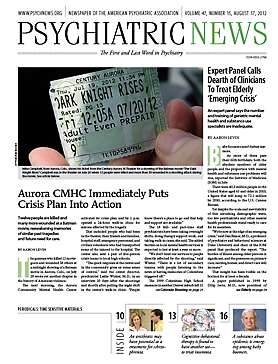Movies and television shows can be a major source of information for the public about mental illness, but accuracy has often been absent from many of these depictions.
Because of media portrayals, schizophrenia in particular has long been stigmatized, due in part to the general ignorance that a substantial part of the public still has about the illness and its symptoms. Movie characters, such as the “homicidal maniac” who has schizophrenia, are examples of the stereotypes on which Hollywood continues to rely.
Patricia Owen, Ph.D., a professor and chair of the Department of Psychology at St. Mary’s University in San Antonio, Texas, and her colleagues sought to understand how schizophrenia was being portrayed in contemporary movies. They viewed 72 movies produced from 1990 to 2010, and identified 41 movies and 42 characters that they determined met DSM-IV-TR criteria for a diagnosis of schizophrenia or that displayed unusual behavior due to schizophrenia.
They found that these movies supported, but also sometimes refuted, stereotypes and misconceptions about the illness. Their study showed that 83 percent of the characters who were depicted as having schizophrenia displayed violent behaviors, with 69 percent engaging in self-harm that ranged from self-mutilation to suicide, and almost one-third of these characters displayed homicidal behavior. Violent behavior was the major stereotype researchers found characters playing into.
“The ‘homicidal maniac’ is one stereotype that has persisted throughout cinematic history, beginning with D.W. Griffiths’ 1909 classic, ‘The Maniac Cook,’ ” said Glen Gabbard M.D., coauthor of Psychiatry and the Cinema, in an interview with Psychiatric News. “The proportion of homicidal patients with severe mental illness who kill in the movies is grossly exaggerated compared to instances of homicide by the severely mentally ill in real life. However, filmmakers view themselves as owing no debt to reality—only to their audiences, who come to the cineplex with specific expectations.” Gabbard is a clinical professor of psychiatry at Baylor College of Medicine in Houston and a professor of psychiatry at SUNY Upstate Medical Center in Syracuse, N.Y.
Owen and her colleagues found that about 25 percent of the film characters who were depicted as having schizophrenia killed themselves, which misrepresented the actual suicide rate for such individuals in the United States, estimated to be between 10 percent and 16 percent. Other symptoms commonly depicted included auditory or visual hallucinations and disorganized thoughts or speech. Seven characters (17 percent) with schizophrenia displayed special talents in areas such as mathematics, science, or music, and five (12 percent) were portrayed as having paranormal abilities such as being able to communicate with “otherworldly and often malevolent forces.”
Owen and her colleagues analyzed the characters’ demographic characteristics, symptoms and stereotypes, causation, and treatment, if any.
Of the analyzed characters, 79 percent were male, and 95 percent were Caucasian. Demographically, the results showed that 45 percent were shown as being of low socioeconomic status, which is consistent with epidemiological data on people with schizophrenia, and 25 percent were of high socioeconomic status. About three-fourths of the films did not attempt to explain causation for the illness, although almost one-fourth implied that experiencing a traumatic event was the reason for a character’s schizophrenia.
Psychotropic medication was used as treatment for over half of the characters portrayed as having schizophrenia, and the myth of love curing the illness was prevalent in almost a quarter of the movies. Group therapy and psychotherapy were used as treatment for only a small number of characters.
“This study appears to be the first to provide an empirically based content analysis of the portrayal of schizophrenia in contemporary movies,” said the researchers. “[The results] will help clarify the prevalence and nature of stereotypes and misinformation found in this widely patronized entertainment medium.”
They also acknowledged a need for further research on ways to correct stereotypes. They added, “Future efforts extending this line of research would contribute to the discourse on the optimal uses of entertainment media to correct misinformation about schizophrenia and to promote an informed understanding of those with schizophrenia and other mental illnesses.”

